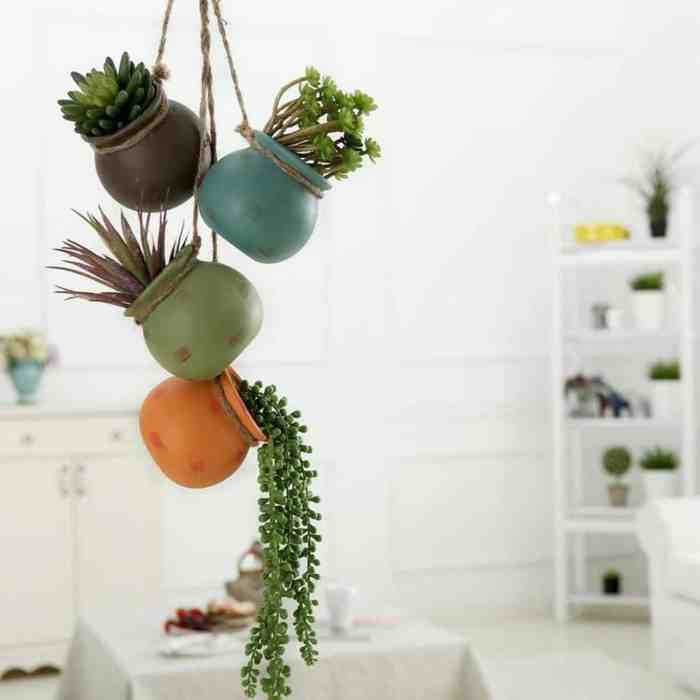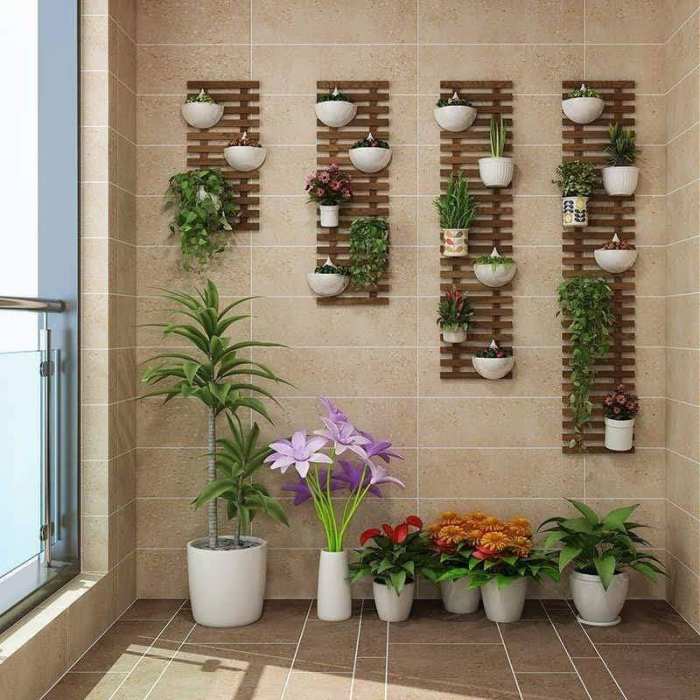Hanging plants and pots have become a popular way to add life and style to any room. From lush greenery to vibrant blooms, these versatile accents can transform your space into a tranquil oasis. Whether you’re a seasoned plant enthusiast or a novice gardener, this comprehensive guide will provide you with everything you need to know about selecting, caring for, and displaying hanging plants and pots.
In this guide, we’ll explore the best plant varieties for hanging pots, discuss the advantages and disadvantages of various plant types, and provide guidance on selecting appropriate hanging pots based on plant size, weight, and material. We’ll also cover different hanging methods, optimal placement and lighting, and essential maintenance tasks for hanging plants.
Plant Varieties
Hanging pots offer a versatile way to add greenery to indoor and outdoor spaces. The choice of plants for these arrangements depends on factors such as the amount of sunlight, the size of the pot, and personal preferences. Certain plant species are particularly well-suited for hanging pots due to their growth habits and tolerance to varying conditions.
Hanging plants and pots are a popular way to add greenery to your home. They can be used to create a variety of looks, from lush and tropical to modern and minimalist. One of the most popular types of hanging plants is those with vines.
Hanging plants with vines can add a touch of elegance and drama to any room. They are also a great way to add height and dimension to a space. When choosing hanging plants and pots, be sure to consider the size and shape of the plant, as well as the amount of light it will receive.
Some popular options for hanging pots include:
- Trailing plants:These plants, such as ivy, pothos, and philodendron, have long, cascading stems that can elegantly drape over the sides of pots. They prefer bright, indirect light and well-drained soil.
- Succulents:Succulents, such as Echeveria, Sedum, and Haworthia, are known for their thick, fleshy leaves that store water. They thrive in well-draining soil and can tolerate bright, direct sunlight.
- Epiphytic plants:Epiphytes, such as orchids and air plants, attach themselves to other plants or objects for support. They typically require high humidity and indirect light.
- Ferns:Ferns, such as Boston fern, maidenhair fern, and asparagus fern, have delicate fronds that add a lush touch to hanging pots. They prefer bright, indirect light and moist soil.
Advantages of Hanging Plants
Hanging plants offer several advantages over traditional potted plants:
- Space-saving:Hanging pots utilize vertical space, making them ideal for small apartments or areas with limited floor space.
- Aesthetic appeal:Hanging plants add a touch of elegance and visual interest to any space. They can create a cascading effect or add height to a room.
- Improved air quality:Some plants, such as spider plants and peace lilies, have air-purifying qualities and can help improve indoor air quality.
Disadvantages of Hanging Plants
While hanging plants offer many benefits, they also have some potential disadvantages:
- Watering challenges:Watering hanging plants can be more difficult than watering traditional potted plants. The soil in hanging pots can dry out more quickly, requiring more frequent watering.
- Limited root space:Hanging pots typically have less root space than traditional pots, which can limit the growth of some plants.
- Pest susceptibility:Hanging plants can be more susceptible to pests, such as aphids and mealybugs, due to their proximity to other plants and the accumulation of moisture in the soil.
Pot Selection and Design

Choosing the right hanging pots for your plants is essential for their health and well-being. Consider the plant’s size, weight, and material when selecting a pot. Larger plants require bigger pots with adequate drainage holes to prevent waterlogging. Heavier plants need sturdy pots made of durable materials like ceramic or metal.
Lighter plants can be placed in pots made of plastic or woven materials.
Hanging plants and pots can add a touch of greenery and life to any home. For those looking for plants that can thrive in sunny conditions, there are many hanging plants that can take a lot of sun . These plants are perfect for adding a pop of color and vibrancy to any room, and they are sure to brighten up any space.
The design of the hanging pot can also enhance the aesthetic appeal of your space. Choose colors and textures that complement the plant’s foliage and the surrounding decor. Consider the shape of the pot to create visual interest and balance.
For instance, a round pot can soften angular lines in a room, while a square or rectangular pot can add structure.
Material Selection
- Ceramic:Durable, heavy, and available in a wide range of colors and designs.
- Metal:Strong and lightweight, but can rust if not properly treated.
- Plastic:Lightweight, affordable, and available in various colors and shapes.
- Woven Materials:Natural and eco-friendly, but may not be as durable as other materials.
Design Considerations, Hanging plants and pots
- Color:Choose colors that complement the plant’s foliage and the surrounding decor.
- Texture:Add visual interest with pots that have different textures, such as glazed, matte, or textured.
- Shape:Consider the shape of the pot to create visual interest and balance.
Hanging Methods

Hanging plants is a great way to add life and greenery to your home. But before you start hanging plants, you need to choose the right method. There are a few different ways to hang plants, each with its own pros and cons.One
common method is to use hooks. Hooks are easy to install and can be used to hang plants from ceilings, walls, or even furniture. However, hooks can be unsightly, and they may not be strong enough to support heavy plants.Another
option is to use brackets. Brackets are more durable than hooks and can be used to hang heavier plants. However, brackets can be more difficult to install, and they may not be as aesthetically pleasing as hooks.Finally, you can also use chains to hang plants.
Chains are very strong and durable, and they can be used to hang plants from any height. However, chains can be more expensive than hooks or brackets, and they may not be as easy to install.The best hanging method for you will depend on your specific needs and preferences.
If you’re looking for a quick and easy way to hang plants, hooks are a good option. If you need to hang heavier plants, brackets or chains are a better choice. And if you’re looking for a more aesthetically pleasing option, chains are the way to go.
Hooks
Hooks are the most common method of hanging plants. They are easy to install and can be used to hang plants from any height. However, hooks can be unsightly, and they may not be strong enough to support heavy plants.
Pros of using hooks:
- Easy to install
- Can be used to hang plants from any height
- Inexpensive
Cons of using hooks:
- Can be unsightly
- May not be strong enough to support heavy plants
Brackets
Brackets are a more durable option for hanging plants. They are typically made of metal or wood, and they can be used to hang heavier plants. However, brackets can be more difficult to install, and they may not be as aesthetically pleasing as hooks.
Pros of using brackets:
- More durable than hooks
- Can be used to hang heavier plants
- More aesthetically pleasing than hooks
Cons of using brackets:
- More difficult to install
- May not be as aesthetically pleasing as hooks
Chains
Chains are the strongest and most durable option for hanging plants. They can be used to hang plants from any height, and they are not likely to break. However, chains can be more expensive than hooks or brackets, and they may not be as easy to install.
Hanging plants and pots have become a popular way to add greenery and style to any room. For those looking to add a touch of elegance, combining hanging plants with curtains can create a stunning visual effect. Whether it’s trailing plants cascading down the sides of curtains or lush greenery framing a window, the combination of hanging plants with curtains creates a harmonious balance between nature and decor.
From lush ferns to vibrant flowers, hanging plants and pots offer endless possibilities to enhance the beauty of any space.
Pros of using chains:
- Strongest and most durable option
- Can be used to hang plants from any height
- Not likely to break
Cons of using chains:
- More expensive than hooks or brackets
- May not be as easy to install
Placement and Lighting
When selecting the optimal placement for hanging plants, consider factors like sunlight, air circulation, and room decor. Adequate sunlight is crucial for plant growth, so choose locations that receive sufficient natural light. Air circulation is also important to prevent disease and promote healthy growth.
Consider the overall aesthetics of the room when choosing plant placement to enhance the decor and create a visually appealing space.
Impact of Lighting
Different lighting conditions have a significant impact on plant health and growth. Bright, indirect light is ideal for most hanging plants, as it provides the necessary energy for photosynthesis without causing sunburn. Low-light conditions can stunt growth and lead to yellowing leaves, while excessive sunlight can scorch leaves and damage the plant.
Understanding the lighting requirements of each plant species is crucial to ensure optimal growth and vitality.
Maintenance and Care

Maintaining the vitality and beauty of hanging plants requires a few essential tasks. Regular watering, proper fertilization, and strategic pruning are crucial for their well-being. Understanding and addressing common challenges like pests, diseases, and wilting ensures their continued health and aesthetic appeal.
Regular watering is essential, but overwatering should be avoided to prevent root rot. Allow the soil to dry slightly between waterings and adjust the frequency based on factors like plant species, pot size, and environmental conditions.
Fertilizing provides essential nutrients for healthy growth. Use a balanced liquid fertilizer diluted to half strength during the growing season. Avoid over-fertilizing, as it can burn the roots.
Pruning
Pruning encourages bushier growth, removes dead or diseased foliage, and maintains the desired shape of hanging plants. Use sharp, clean shears to trim stems just above a leaf node. Regular pruning promotes air circulation and reduces the risk of pests and diseases.
Challenges
Pests like aphids, mealybugs, and spider mites can infest hanging plants. Inspect them regularly and treat infestations promptly with insecticidal soap or neem oil. Diseases such as powdery mildew and root rot can also occur. Proper watering, ventilation, and fungicide application are crucial for prevention and treatment.
Wilting can indicate underwatering, overwatering, or root damage. Adjust watering frequency or check for root rot. If root rot is present, repot the plant in fresh soil and remove any damaged roots.
Ultimate Conclusion: Hanging Plants And Pots

With the right knowledge and care, hanging plants and pots can bring beauty and vitality to your home for years to come. Embrace the joy of gardening indoors and create a lush, inviting space that reflects your personal style.
Essential Questionnaire
What are the best plant varieties for hanging pots?
Some of the best plant varieties for hanging pots include trailing plants like ivy, ferns, and pothos, as well as cascading plants like spider plants and begonias.
How do I choose the right hanging pot for my plant?
When choosing a hanging pot, consider the size and weight of your plant, as well as the material of the pot. Terracotta pots are porous and allow for good drainage, while plastic pots are lightweight and durable.
How often should I water my hanging plants?
The frequency of watering will depend on the type of plant and the environment in which it is placed. Generally, hanging plants should be watered when the soil feels dry to the touch.